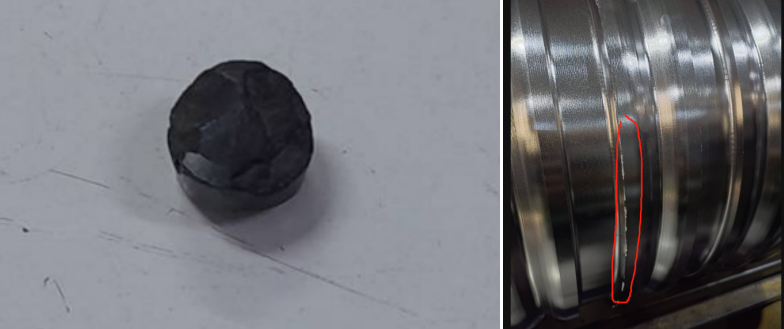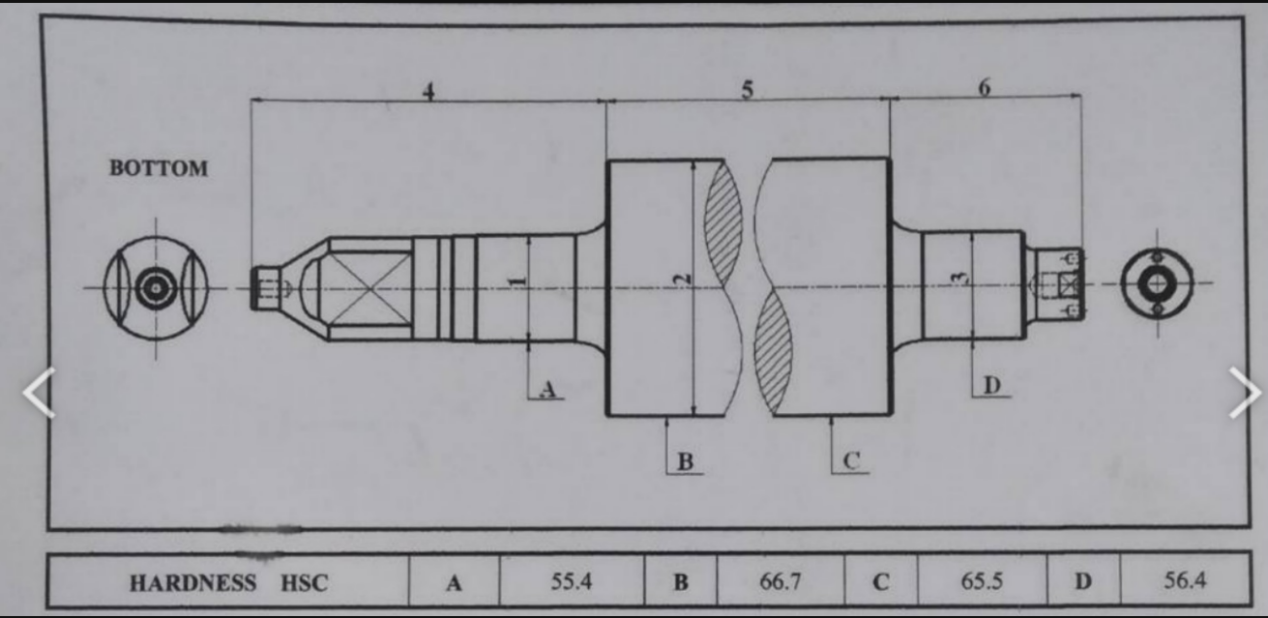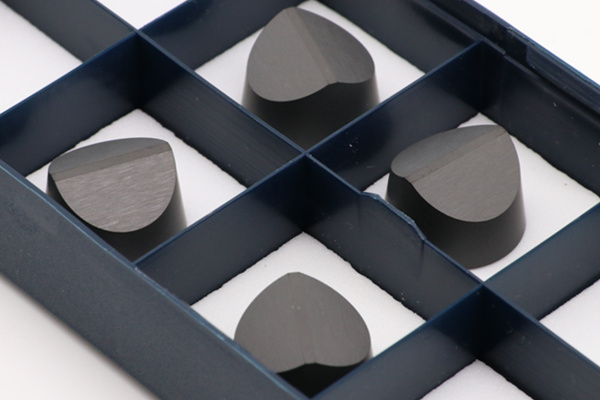

Rolls use the pressure generated by a pair or a group of rollers when rolling to roll steel, so that the metal undergoes plastic deformation and obtains the finished product required by customers. The quality of the rolls directly affects the working efficiency of the rolls, the quality and output of the rolled products, etc. Therefore, the materials and performance of the rolls used are different depending on the occasion.
According to the different manufacturing materials, rolls can be divided into chilled cast iron rolls, high nickel-chromium alloy cast iron rolls, high-speed steel rolls, forged steel rolls, etc.
Roller blanks generally have casting defects such as pores, sand holes, and sand inclusions. During turning, the impact resistance, high temperature resistance, and wear resistance of the blades are required to be high. In the past, carbide tools were used to process rolls. When processing rolls with a hardness of HSD75 or above, the rolls often failed to move, the tools were not wear-resistant, and the blades collapsed, which affected the production and processing efficiency.
Therefore, for high-hardness roll processing, it is recommended to use BTS2800A brand CBN tools. BTS2800A is a CBN material grade specially developed for turning rolls. It takes into account wear resistance and impact toughness. Through the combination of different cutting edges, it can cope with harsh working conditions such as high hardness, large cutting depth, and strong intermittent.
Chilled cast iron roll
Chilled cast iron is a roll material that has been used for a long time. The roll body matrix contains more carbides, good wear resistance, and a large hardened layer depth, which requires high wear resistance of the tool.
For example, when turning the outer circle of a chilled cast iron roll, the RNMN2010 model CBN blade can be used. It has strong wear resistance, high metal removal rate, and the cutting depth is several times that of a carbide tool.
Generally, RNMN200800, RNUN200800, RNMN150700, RNUN160800, RNUN150716, and RNMN150716 size cubic boron nitride blades are used to process cast iron rolls.
High nickel-chromium alloy cast iron roll
Refers to cast iron rolls with a chromium content of 11% to 30%. They have high wear resistance and hardness, and also have higher toughness and strength than ordinary cast iron. They have higher requirements for wear resistance and impact toughness of the tool.
When turning the outer circle of high nickel-chromium alloy cast iron rolls, BTS2800 brand SNMN1608 model CBN blades can be used. They have strong impact toughness and will not break when encountering casting defects such as sand inclusions and pores in the rolls.
High-speed steel rolls
High-speed steel rolls contain tungsten carbide materials such as tungsten, molybdenum, chromium, vanadium, and niobium. They have high hardness, high wear resistance, good hot red hardness and toughness, and are difficult to turn with ordinary tools.
When turning the outer circle of high-speed steel rolls, BTS2800A brand RNMN2010 model CBN blades can be used. The blade hardness is about HRC98 and has good wear resistance. When turning the rolls with large margins, there will be no severe wear or motionlessness.
The commonly used blade models for processing forged steel cold rolling rolls with BN-S20 brand cubic boron nitride blades are SNMN120712, SNMN120412, SNMN120408, and RNMN120400.
This time, Moresuperhard received feedback from a customer who used a solid CBN blade to process a cast iron roll, and severe edge chipping occurred. The customer sent a picture, and it can be seen from the picture that the edge chipping is very serious. This is not a normal phenomenon. There are also obvious signs of edge chipping on the roll. What is going on? Let's find out.

Normally speaking, the solid CBN processing of cast iron rolls is no problem, we asked the specific material and hardness of the roll, we choose the CBN grade is also fully able to process customers' workpieces. So what's the problem?


We asked the customer about the processing parameters. The customer took a photo of the machine's operating panel and it seemed that there was no problem. However, we noticed that the specific cutting depth could not be seen in the photo, so we asked the customer. The customer said the cutting depth was 0.5mm. At this time, we understood where the problem was. The blade model selected by the customer was RCGX120700VS15015, and the chamfer width of the cutting edge was 1.5mm. However, the customer's cutting depth was only 0.5mm. So this is the main reason for the chipping.
Some people may not understand, thinking that a wider chamfer should have a better effect on anti-chipping. Our engineers explained as follows:
When the PCBN insert has a small cutting depth but a large chamfer is selected, it is possible that the edge will break due to the following reasons:
Changes in cutting edge strength: Larger chamfers will make the cutting edge blunt. Although this will increase the strength of the cutting edge and help it withstand greater cutting forces, this stronger cutting edge strength may not be fully effective when the cutting depth is small. Because the cutting depth is small, the cutting force is relatively small, and the larger chamfers increase the contact area between the cutting edge and the workpiece, reducing the cutting force per unit area. This may cause the cutting edge to fail to effectively cut into the workpiece during the cutting process, but may easily cause friction on the workpiece surface, causing the cutting edge to be subjected to additional impact force. When the impact force exceeds the bearing limit of the cutting edge material, it is easy to cause chipping.

2. Change in cutting force direction: A larger chamfer will change the direction of the cutting force, directing it more toward the side of the tool. When the cutting depth is small, the cutting force on the tool itself is small. At this time, the change in the direction of the cutting force may cause the tool to bear an uneven force system, which may easily cause the edge to be locally subjected to greater stress. When the stress is concentrated to a certain extent, it will cause the edge to break.
When cutting cast iron surface and black skin surface layer, the cutting depth should be increased as much as possible under the condition that the machine tool power allows, otherwise the cutting edge tip will break due to cutting the hardened layer of the workpiece surface, resulting in abnormal wear. For example, when peeling and turning a hot-rolled D80 round steel part, assuming that the maximum and minimum dimensions of the round steel part are 82 and 78 respectively due to its ellipse, the first cutting depth must be less than 78. Since the tool tip is continuously processed, it can effectively ensure that the tool tip does not break, thereby increasing the service life of the tool.
Therefore, we recommend that customers increase the cutting depth to 1~2mm and try again. If the cutting depth does not change, use a blade with a narrower cutting edge, such as RCGX120700VS05020.
If you need CBN inserts for roller machining but don't know how to choose the right size, please contact MoreSuperHard, we will give you professional recommendations based on your specific working conditions.
---EDITOR: Doris Hu, Erin Zhang
--POST: Doris Hu
Semiconductor Industry Solutions
PCD & PCBN Tools Grinding Industry
Diamond Cutting Bruting Polishing
Add: No.171 Zhongyuan Rd, Zhongyuan District, Zhengzhou, 450001, Henan, China
Tel: +86-371-86545906
Phone / Whats App: +86 18339903057
E-mail: [email protected]



